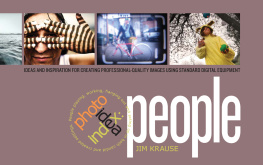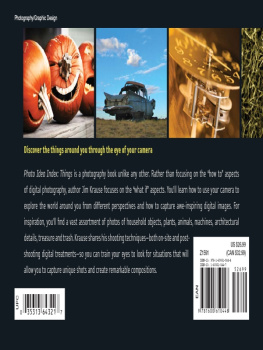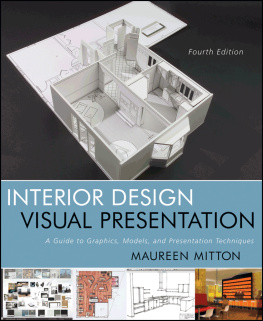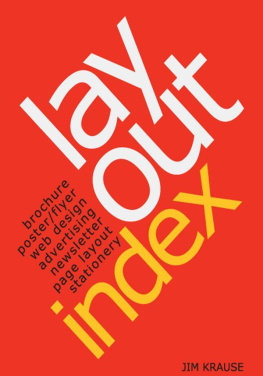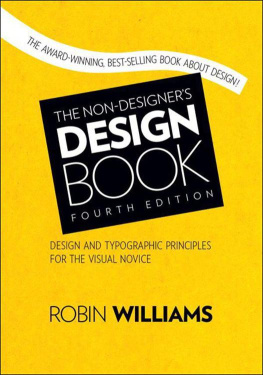Visual Design
Ninety-five things you need to know.
Told in Helvetica and dingbats.
Jim Krause
Visual Design
Ninety-five things you need to know. Told in Helvetica and dingbats.
Jim Krause
New Riders
Find us on the Web at www.newriders.com
To report errors, please send a note to
New Riders is an imprint of Peachpit, a division of Pearson Education.
Copyright 2015 by Jim Krause
Acquisitions Editor: Nikki Echler McDonald
Production Editor: Tracey Croom
Proofreaders: Jan Seymour, Emily Wolman
Indexer: James Minkin
Cover Design and Illustrations: Jim Krause
Interior Design and Illustrations: Jim Krause
Notice of Rights
All rights reserved. No part of this book may be reproduced or transmitted in any form by any means, electronic, mechanical, photocopying, recording, or otherwise, without the prior written permission of the publisher. For information on getting permission for reprints and excerpts, contact .
Notice of Liability
The information in this book is distributed on an As Is basis without warranty. While every precaution has been taken in the preparation of the book, neither the author nor Peachpit shall have any liability to any person or entity with respect to any loss or damage caused or alleged to be caused directly or indirectly by the instructions contained in this book or by the computer software and hardware products described in it.
Trademarks
Many of the designations used by manufacturers and sellers to distinguish their products are claimed as trademarks. Where those designations appear in this book, and Peachpit was aware of a trademark claim, the designations appear as requested by the owner of the trademark. All other product names and services identified throughout this book are used in editorial fashion only and for the benefit of such companies with no intention of infringement of the trademark. No such use, or the use of any trade name, is intended to convey endorsement or other affiliation with this book.
ISBN 13: 978-0-321-96815-9
ISBN 10: 0-321-96815-8
9 8 7 6 5 4 3 2 1
Printed and bound in the United States of America
Introduction
If I were to describe the intended tone of this bookboth in terms of its text and imagesId say its meant to come across as concise, and also conversational; to-the-point, but not without its share of meandering anecdotes; and serious while still delivering hints of sass and humor. In other words, just the sort of passionate, focused (and sometimes playfully irreverent) tone you might expect when talking design or art with anyone whos similarly interested in creativity.
Visual Design is for designers, illustrators, photographers, fine artists, and pretty much anyone else involved in creating art for professional or personal purposes. This is a book thats filled with highly usable and widely applicable principles of aesthetics, style, color, typography, printing, andvery importantlythe behind-the-scenes conceptual thinking that goes into coming up with layouts, illustrations, and photographs that are visually and thematically attractive and engaging.
The 95 topics covered in this book are offered at a rate of exactly one subject per spread, and each topic is presented through more or less equal parts text and imagery. Nearly all the books content is delivered through a visual vocabulary of Helvetica and dingbats (typographic families of symbols, imagery, and ornaments). Which brings up the obvious questions, Exactly why is this books subject matter presented using Helvetica and dingbats, and why are there 95 topics?
First off, there are 95 topics simply because the rounder and more complete-feeling number of 100 wouldnt fit into the 240-page format of this book. Thats all. (But that doesnt mean anything important was left out: As any writer could tell you, there are always ways of combining two or more subjects under the umbrella of a single larger topic.)
As far as the Helvetica and dingbats go, to explain their role in Visual Design is also to explain and emphasize one of this books primary goalsthat of being able to offer artists a ton of highly applicable information without overly influencing the ways in which that information might be put to use. So here goes: Helvetica was chosen as the font for this books textand for nearly all of the words used within its imagessimply because Helvetica is one of those very rare fonts that cannot only deliver a wide range of thematic conveyances (think, for instance of the elegant look of a headline set in the thinnest possible weight of Helvetica versus the commanding boldness of a block of text set in Helvetica Black), but it can also act as an almost invisible thematic component for a layout or illustration whose other visual elements are meant to set the pieces mood. Know many other fonts that can claim this remarkable set of qualities in quite the same way? I dont.
Dingbats and ornaments are used as the main visual element for the vast majority of this books images for similar reasons: Because dingbatslike Helveticatend to convey themselves without a great deal of self-aggrandizing fanfare, and therefore are capable of adapting to a wide range of styles and moods within the layouts and illustrations they inhabit.
Thats why Helvetica and dingbats have been used to deliver this books informational, conceptual, and visual content: In order to spark inspiration and ideas in the minds of viewers without calling any more attention to these visual components than necessary. Also, on the level of visual entertainment alone, I hope you enjoy seeing the ways in which characters of the Helvetica font familyand those from a variety of dingbat familieshave been used to uniquely illustrate this books subject matter.
Just a couple more notes about the content of Visual Designone regarding the depth of coverage seen throughout the book, and the other about the software mentioned in its pages.
Some of this books topicslike those dealing with broad aspects of composition and aesthetics (primarily covered in )are presented in considerable depth and completeness. Other subjectssuch as typography and colorwill themselves be topics that fill entire books in future additions to the Creative Core series. Naturally, the attention these large-scale topics receive in this book is abridged in comparison to how they will be covered in volumes of their own, but readers should still find that these subjects have been dealt with in a solid, practical, instructive, and enlightening way within the chapters of Visual Design.
This book was created using the same trio of software programs that most designers, illustrators, and photographers use to create their own works of design and art: Adobe InDesign, Illustrator, and Photoshop. In most cases, when these programs are mentioned, it is without a great deal of specifics in terms of what buttons to push or what pull-down menus to activate. Why is this? Its simply because software changes quickly and often, and the hope is that the information in this book will be of a much more long-lasting nature than is generally found when it comes to computers and software. So, if you come across a tip in this book about using such-and-such program to help you perform such-and-such task, I hopeif necessaryyoull be willing to open that programs Help menu to find out how the current version of the software handles these matters. (To me, this is really the best way of learning new things about software anywaysince it almost always leads to discoveries of other menu items and tools that may come in handy for other tasks.)
Finally, thank you for taking a look at


